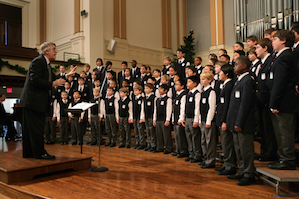Great Inspiration to Audition for Napa Valley Youth Symphony
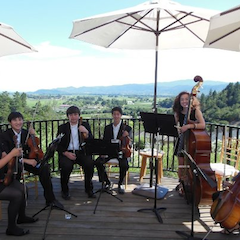
With auditions for the Napa Valley Youth Symphony coming up this weekend (Aug. 25-26) we asked Ming Luke, the music director, what qualities he looks for in a young musician.
Some youth symphonies look for talent alone and if you make a mistake, even a small mistake in the audition, you’re out. We're interested in talent, of course, but we’re also interested in motivation and we’ve found that sometimes those with genuine interest and passion become the best players as well.There was a bassoonist a few years ago, Molly Rubin. She was having a lot of difficulty with scales during her audition, but showed high interest and when she joined the symphony she really connected with the coaching and the repertoire. It turned out she also simply needed a better instrument. That greatly improved her playing. By the time she graduated two years later she got into to Indiana University, which of course offers one of the best music programs in the country. So if we’d judged Molly solely on her technical ability during the audition we would have probably said, "Well, why don’t you come back in a year and we’ll see where you are."
During the interview we ask not only where you go to school and how long you’ve been playing but we ask whether you play in an ensemble and what sort of music you listen to. In another youth group I direct, in Modesto, there was a young lady who came to the audition and had very little ability, but played for hours. During the interview it came out that her family was dirt poor. On technical ability alone she didn’t belong but we offered a trial period, as we do with everyone, and within a year she showed not only great improvement but also great promise. She’d never had a formal music lesson. Eventually, she got into the Young Person’s Symphony Orchestra in Berkeley.
She’s just a fantastic person and while her family is still poor, someone donated a violin, and then she got accepted to some summer camps on scholarship. This would never have happened if we hadn’t made an effort to find out who she was.
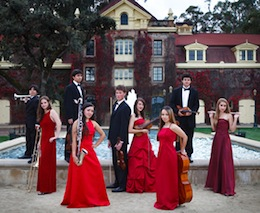
We asked Luke about the role of Emotional Intelligenced (EQ) in musicians.
'Executive skills' is the key buzzword these days. Perseverance and cooperation. Those used to be fuzzy terms, but no longer. And you see it all the time. It’s just what I’ve been talking about. There’s always a ‘genius,’ the person with extraordinary talent, but no matter how much talent you have, at some point the music will get beyond you. And that can end a career, because you don’t see a way around the obstacle. But as along as you have dedication and passion, and you’re working hard and working together, let’s say in an ensemble, you can survive and succeed.It’s not just about your part. That’s what you have to realize. If you’re a violinist, for example, you have to watch what’s on the music stand, the section, and you have to watch the conductor, and you have to listen to how you’re playing as well as how the people around you are playing. And when it comes together it’s thrilling. It’s that nonverbal part of musical language that's’ so important.
We just returned from a Mahler festival in Jihlava, in the Czech Republic. The students played better than they’ve ever played, and you realize how much this kind of success comes out of the kinship and bonding during the trip. They really got into the flow. It’s what athletes call being "in the zone." Flow is the buzzword, which comes out of the work of the Hungarian psychologist Mihaly Csikszentmihalyi. When you’re in "the flow" you’re cutting out that voice that says, "oh no, I missed a note." You’re totally in the creative process, you’re totally caught up in the music — what you’re creating and what’s being created around you.
For appointment, email auditions@nvyso.org Tip from Ming Luke: “Students should prepare a work that adequately shows their ability on their instrument, and a scale of their choosing. Sight-reading excerpts may be given.”
S.F. Boys Chorus Auditions
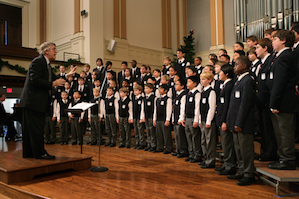
Last week we described programs at the Ragazzi Boys Chorus on the Peninsula and at the Piedmont East Bay Children’s Choir. This week we’re focusing on the San Francisco Boy’s Chorus. As the Chorus Director Ian Robertson, put it, “Every chorus has its own identity. Ours is very much tied to the city of San Francisco. We sing at all the city events, whether singing the national anthem before a Giant’s game, or with the opera as we will be in November in Tosca.”
The chorus began in 1948 and includes about 325 boys split into three groups: a concert group of 40, which last year sang in St. Petersburg; an intermediate group of 35, which that tours locally and last year went to Vancouver; and then the rest in a series of apprentice groups, which provide the ladder to move up through the chorus. Tuition is $1300; financial aid is available.
The chorus, which teaches the Kodaly method and offers complete courses in music theory, has satellite campuses in the East Bay and in Marin (San Rafael). The satellites run their own schedules, and groups come together in the city periodically. Boys promoted to the concert group must come to the city twice a week for all rehearsals.
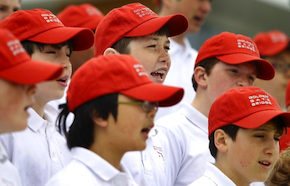
Auditions begin on Sept. 8 and will be held at the chorus’s three locations. We spoke to Robertson, who explained the audition process.
The young men come in small groups, we get to know them, then we play musical games, we sing something together and then we would ask an individual, "Do you have a favorite song? Ah well, then would you like to sing a little bit of it?" We explore in a very gentle way the personality of the young man. And we’re trying to see if they have an innate sense of rhythm, which most boys do, and can they match pitch. And if they don’t respond to the right pitch they can be guided toward it ...We also put them in a circle to see how the boys relate to each other. Are there any behavior problems? Are they able to focus? Everyone has a probation period and sometimes we might say, "It might be better to wait a while before joining the chorus."
The youngest group includes 4½ to 6-year-olds; no audition necessary. Auditions are for boys ages 6 to 12. Boys older than eight may be accepted but not without prior musical training. The usual standard is the ability to read music.
“We usually see 50 to 60 boys in an audition,” says Robertson. “I would say we end up taking 60 to 70 percent.”
This is a ‘graduate’ program for boys whose voices evolve into the tenor range, so it’s quite possible one could stay in the program from a very young age all the way to college.
To register go to: sfcb.org/new
East Bay Music Together
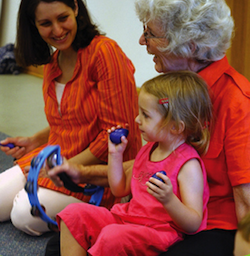
Tell me again why it’s so important that children listen to music. Actually, not just listen but engage music. And from infancy on. Why is that?
Alright here it is again: The research has been piling up over the last 25 years and more and more studies are documenting the difference music makes in learning math and reading and in social development and spatial understanding — among kids who actively engage in music. According to one Canadian study done by the psychology department at McMaster University (published in May 2012) researchers found that among other things, “infants assigned to the active musical experience showed superior development of prelinguistic communicative gestures and social behavior compared to infants assigned to the passive musical experience.”
And so one result of all this research is that there are more and more programs directed toward infants and toddlers. One of the most popular, and well established, is Music Together, which has eight locations in the East Bay alone, including one Oakland directed by Julie Tanenbaum. She is a certified Music Together® teacher who has also been teaching piano in the Bay Area for more than 20 years.
“You see the difference music makes in autistic kids who have never spoken and through music are able to speak; stroke victims who are able to walk. [Former Arizona congresswoman] Gabby Giffords learned to speak again by singing. So it seems that we’re all born with this set of neurons that's intended for music making and when immersed in music at an early age those neurons get connected up.”
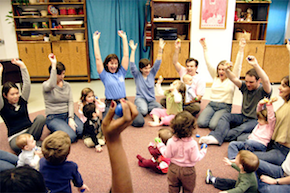
Tannebaum says the research has pinpointed reaching one’s music “potential” at age 5. “Whatever neurons you've got connected up by being immersed in music stabilize around the age of five. In other words your music potential stabilizes. Your skill level can increase but your talent stabilizes. The particular composition of neurons that allows you to hear accurately and produce music accurately is set. What we do at Music Together is impart basic music competence — which means being able to move with accurate rhythm and sing in tune independently.”
But one revelation in all this is that it takes a parent, or two, to get the proper level of engagement.
“That’s part of what we do, we immerse the family into a rich music environment. It’s absolutely critical to get the family involved. We are merely facilitating the interaction between parent and child, giving them tools and the confidence to make this happen. And it doesn’t matter if they don’t sing in tune. It just matters if they sing. The idea is that we want kids to grow up being competent, confident, joyful in the music of their culture.”
And other cultures as Tannebaum points out. Music Together’s musical diet includes rhythms from Africa, Asia, and Eastern Europe, along with eight different types of scales. “When kids hear these early that becomes part of their mother tongue, and that’s really the hall mark of this program: the breadth of the musical language offered.”
Tanenbaum’s programs brings between 800 and 1,100 kids every ten weeks into the fold, as it were. IN 15 years, 25,000 families have taken her courses. Which run for 10 weeks, once a week, for $215. That includes songbook, DVDs, a musical growth chart, other take-home materials, and two make-up classes. The program is focused on children between infancy and the age of 7. There are eight locations in the East Bay. Call (510) 848-SING.
Emeryville Taiko: Drum and You Are on Your Way
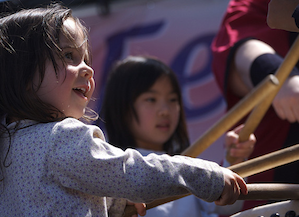
Taiko, or “drum” in Japanese, is a relatively modern adaptation of an ancient form of communication, used not least on battlefields, where orders were encoded in drumming sets. It was rediscovered in Japan in the 1950s and in the last 25 years has become increasingly popular in America, among other places, and especially here in the Bay Area. It has also become increasingly popular among women, of all ages, according to Sally Horn, who heads Emeryville Taiko:
In the last seven or eight years, more and more women have begun coming to the classes. It’s actually a trend that started in Japan; women found it because they had more free time, and could use it as a form of exercise.I think this kind of drumming is appealing because it involves so many different things: various cultural traditions, music, movement and the martial arts. It’s different from western drumming in the sense that there’s no written music to follow. It’s all learned from listening and memorizing.
But, above all, it’s just fun, it’s physical, it’s challenging, it feels good, and it’s "immediate." As opposed to a flute or a violin where you may need months, or years, to refine a sound. With Taiko the moment you hit the drum you are on your way.
Emeryville Taiko has up to 60 students at any one time — ages 8 to 86, and 75 percent are women. Classes offered include intro, beginner, and intermediate. $12 for two hours. Eight to 12 people in a class. Classes are Mon. to Thurs. from 7-9 p.m. and Sat., 10 a.m.–3 p.m. There is an open house on Sept. 15. Free classes: 9:45 a.m. for kids; 11 a.m. and 1 p.m. for adults. Look for them also at the Solano Stroll on Sept. 9.
One other thing: The group is looking for a new space, in Oakland, Emeryville, or Berkeley. They’re good until the first rain, when a leaky roof will put a stop to things. “The problem is, we’re loud,” says Horn. “And we need somewhere that’s safe, to store the equipment. We could get by with 1,500 sq. ft. but 2,000 to 3,000 would be ideal.”
For more information go to etaiko.org.

